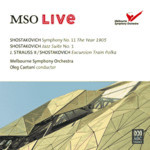
Symphony No. 11 in G minor, Op. 103 / Jazz Suite No.1 (Rec 2005)
 $25.00
Out of Stock
$25.00
Out of Stock6+ weeks add to cart
SHOSTAKOVICH
Symphony No. 11 in G minor, Op. 103 / Jazz Suite No.1 (Rec 2005)
Melbourne Symphony Orchestra / Oleg Caetani
[ ABC Classics / CD ]
Release Date: Wednesday 1 March 2006
This item is currently out of stock. It may take 6 or more weeks to obtain from when you place your order as this is a specialist product.
"A hugely entertaining disc – unhesitatingly recommended"
(MusicWeb Feb 2006)
"Much has been written on the programmatic content of Shostakovich's 11th Symphony, so I won't go into it in any detail now. The piece has its critics, but there is no denying its atmosphere and grim sense of purpose. Oleg Caetani is not a name you would immediately associate with a whole programme of Shostakovich, but he studied in Moscow with Kyrill Kondrashin, and by the showing on this disc he seems to know his stuff. [He has also recorded several of the Shostakovich symphonies for the German company Arts. Ed.]
With the market now replete with different versions of Shostakovich's symphonies I am delighted to be able to say that one need not compromise by choosing this recording. Audience noise is acceptably low, and the Melbourne Symphony Orchestra sound suitably Russian – the vibrato from the principal trumpet seeming entirely appropriate here. There is a potent sense of menace in the growling bass lines, and moments of climax are well handled – just listen to the build up from 11:52 into 9th of January until the end of the drums at 15:58 and then ask yourself if you've ever heard it played quite so hair-raisingly: the rising brass lines from 13:36 are a nightmarish tour de force!
Somebody else who knows his stuff is Rudolf Barshai, and it is his recording with the WDR Sinfonieorchester on the bargain Brilliant Classics label which I used as a sort of 'control'. It's a tricky toss-up, with Barshai perhaps being slightly more compact and convincing in some of the quieter moments. I find Caetani's lower strings in the in memoriam a little too distant and indistinct – Barshai's if anything slightly too close and thumpy, though I must admit I do like a solid bass pizzicato. The MSO beats the WDR for intonation in the tricky low brass and wind section later on in this movement, and the Australians manage to make a Hollywood tear-jerker of the long crescendo, before jack-booted drums once again put the lid firmly on such sentimentality. The final alarm bell in Tocsin is another point of reference in two excellent versions of the final movement. Barshai's tuned bells ring out defiantly and refuse to lie down when everyone else has finished, Caetani's stick out slightly less but sound a little more natural, and any further kitchen department noises are drowned by ecstatic applause.
Having had such a marvellous dramatic feast of revolutionary fervour, we are granted a brace of lollipops as comfort food. Everyone should have the Jazz suite No.1 in Gennady Rozhdestvensky's USSR Melodia version (once available on a BMG 'twofer'), and indeed, the poor slide guitar player can in no way match the Russian solo, which I always play if I really need cheering up. The performance in general is good however, with restrained saxophones, witty percussion and eloquent brass. The foxtrot is a little slow for my taste, which might be another reason why the slide-guitar is made to sweat a little more than is necessary.
Never mind, we are also treated to a number I hadn't heard before: Shostakovich's arrangement of Strauss's Excursion Train Polka. This is of course fluff with which to entertain the likes of Stalin, but there are nice touches, such as the tick-tock percussion and impertinent xylophone which are typical Shostakovich fingerprints. As an encore it provides a fitting close to a hugely entertaining disc – unhesitatingly recommended."
(MusicWeb Feb 2006)
(The Guardian May 2005)
Tracks:
Dmitri SHOSTAKOVICH (1906-1975)
Symphony No. 11 in G minor, Op. 103 The Year 1905 (1957)
Jazz Suite No.1 (1934) [9:17]
Johann STRAUSS II (1825-1899) arr Shostakovich (1940)
Excursion Train Polka [2:22]

